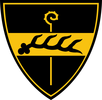Grief
|
Grief
City of Rosenfeld
|
|
|---|---|
| Coordinates: 48 ° 16 ′ 0 ″ N , 8 ° 42 ′ 20 ″ E | |
| Height : | 644 m above sea level NHN |
| Area : | 11.33 km² |
| Residents : | 926 (Jan. 1, 2016) |
| Population density : | 82 inhabitants / km² |
| Incorporation : | 1st January 1975 |
| Postal code : | 72348 |
| Area code : | 07428 |
|
View of Leidringen
|
|
Leidringen is a district of the city of Rosenfeld in the Zollernalbkreis in Baden-Württemberg ( Germany ). The place is south of Rosenfeld.
Geographical location
Leidringen is located about two and a half kilometers southwest of Rosenfeld, about four kilometers northwest of Dautmergen and about four kilometers east of Trichtingen .
history
The noble lords of Leidringen, related to the founders of the Sankt Georgen monastery in the Black Forest , lived in the village until the 13th century. However, they were ousted by the monastery, the greatest landlord . The state rule came to Württemberg via the dukes of Teck in 1317 .
From the 14th century, Leidringen belonged to the Rosenfeld office . After its dissolution in 1808, the place belonged to the Oberamt Sulz and from 1938 to the district of Balingen .
A local book of Leidringen with the history of its origins was published by the teacher Wilhelm Lechler and Heinz Erich Walter in 1975.
On January 1, 1975, Leidringen was incorporated into the city of Rosenfeld.
Culture and sights
music
- Liederkranz Leidringen eV (founded 1894)
Culture
Costume
The folk costume is still fairly well preserved in the Oberamt Sulz in 1863 and is approaching the Black Forest costume in the north-western part of the district; There, as in Dornhan and the surrounding area, the men wear wide-rimmed hats (slouch hats), a cloth skirt, mostly blue in color, with a short waist, with large, flat, overlapping white metal buttons; only at the waist are the buttons noticeably far from each other and between them a design of light silk is quilted. The vests are made of dark Manchester or cloth with flat buttons and, like the skirts, are lined with green. The pants made of black leather or stuff are worn short along with white stockings and strap shoes. The single boys in newer tents often wear the cloth doublet instead of the skirt and the trimmed cap instead of the hat. The female sex wears the well-dressed German bonnet and over it the delicate, yellow straw hat with black-dyed straw strings and rosettes, dark smocks, or if this is missing, wide, richly pleated shirt sleeves, a black goller with light blue, sometimes red, fairly wide edging or in front edged in blue and red at the back, pleated black or blue Wilfling skirts, hips on the hips, dark apron with red or light blue ribbons, white stockings and shoes. The women usually have somewhat simpler, dark clothes. The costume in Aistaig and Weiden is somewhat closer to the costume in the Schappacher Thale; Here, as in several other places (see above), the so-called Schappeln are worn by single women at festivities. On the right side of the Neckar, especially in the so-called Mühlbach villages, the costume shows some affinity with that of the Unterland, the slouch hat of the Black Forest disappears and the so-called three-cornered hat takes its place. The most beautiful, most purely preserved costume can be found on the so-called little Heuberg in the towns of Bickelsberg, Brittheim and Leidringen; Here one meets with the men the three-pointed hat (with the single boys often the cap), the blue skirt (in Leidringen the white double skirt) with standing collar, wide waist, flat, tightly set, overlapping steel buttons, red or blue Chest kerchiefs with roll buttons, very wide, light blue suspenders, yellow leather trousers and strap shoes. The female figures wear richly pleated blue Wilfling skirts, red camisoles with a wide bib that is laced with light blue and green ribbons, German bonnets, white stockings and white aprons. In Leidringen, blue ribbons are worn on the German bonnet. The well-dressed, so-called foreheads, that is, black bonnets that were used in the past, mainly in Bickelsberg and Brittheim, that had so-called schnepps on the forehead and both cheeks, have unfortunately recently gone. In Leidringen, traditions and customs are repeatedly passed on to the next generation. An association tries not to shut itself off to the changing times and to combine the old with the new.
- Trachtengruppe Leidringen eV, founded in 1966
- OGL “green tree” Leidringen eV
religion
The Protestant St. Peter's Church is located in Leidringen .
Museums
- Leidringen local history museum, Rottweiler Str. 33., 72348 Rosenfeld-Leidringen
Sports
sports clubs
- Sportvereinigung Leidringen e. V., founded in 1962
- Motorsportclub Leidringen eV, founded in 1977
- Angelsportverein Leidringen eV, founded in 1982
Sports facilities
- Two sports fields
- Kleiner-Heuberg-Halle
literature
- Erhard Lazi (Ed.): The Zollernalbkreis . Konrad Theiss Verlag , Stuttgart 1979, ISBN 3-8062-0205-2 , p. 306.
Web links
Individual evidence
- ^ Johann Daniel Georg von Memminger : Description of Württemberg . Cotta, Stuttgart and Tübingen, 3rd, completely revised and greatly increased edition. 1841, p. 724.
- ↑ Leidringen: History
- ↑ Coat of arms of Leidringen. Retrieved May 4, 2017 .
- ^ Federal Statistical Office (ed.): Historical municipality directory for the Federal Republic of Germany. Name, border and key number changes in municipalities, counties and administrative districts from May 27, 1970 to December 31, 1982 . W. Kohlhammer, Stuttgart / Mainz 1983, ISBN 3-17-003263-1 , p. 541 .
- ^ Description of the Oberamt Sulz 1863
- ↑ Costume
- ↑ Leidringen: Church
- ↑ MSC-Leidringen: club history
- ↑ Leidringen: Associations

